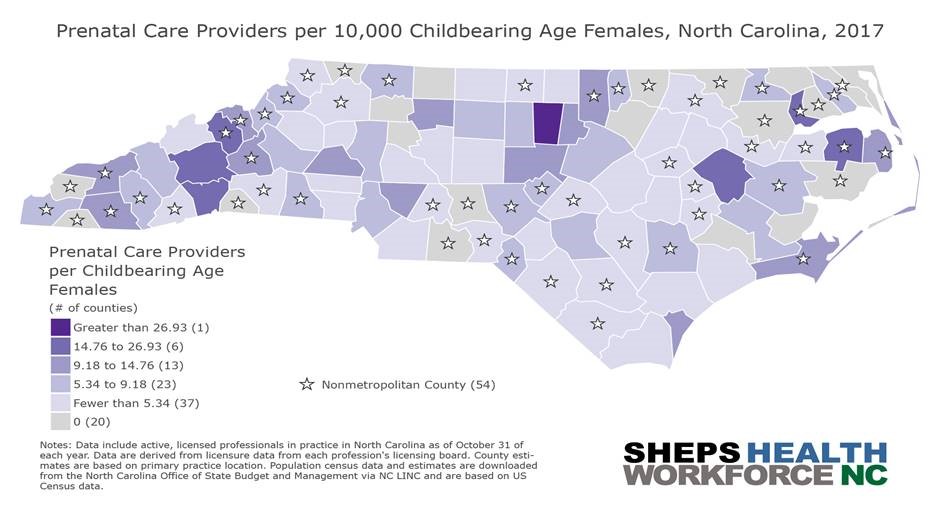

A significant barrier to women receiving prenatal care, especially in rural areas of North Carolina, is the lack of availability of perinatal health services. Most pregnant women experience low-risk pregnancies and can seek prenatal and labor-and-delivery care from various health care providers beyond obstetricians and gynecologists (OB/GYN), such as family physicians, nurse practitioners, physician assistants, and certified nurse-midwives. However, many of these providers are concentrated in metropolitan areas. Only 80% of North Carolina counties have a medical practitioner designated as a prenatal care provider. Women living in rural areas often have to travel a longer distance to reach designated prenatal care providers.1

Another barrier that may prevent or delay women from receiving prenatal care, especially those from low-income families, is a lack of child care and transportation. National estimates suggest that 36% of low-income women have missed medical appointments as a result of child care or transportation problems. 2
The use of telemedicine technologies to provide prenatal care may help alleviate barriers to care for women. Telemedicine is the use of telecommunications and digital communication technologies to deliver and facilitate health care and health-related services. Examples of telecommunications technologies used in telemedicine include live video conferencing, store-and-forward [a], and remote patient monitoring (RPM) [b]. Telemedicine services may consist of medical care, mental health treatment, health information services, and provider and patient education.3
Research studies and data suggest that certain portions of prenatal care can be provided safely and effectively using telemedicine technologies.2,4,5 There is a range of opportunities for telemedicine provision for prenatal care and other obstetrical services such as postpartum care.
| Maternal Health Services Delivered via Telemedicine | ||
| Prenatal Care | Postpartum Care | Prenatal/Postpartum Care |
| Virtual Prenatal Care Visits | Lactation Support | Mental Health Care |
| At-Home Monitoring: weight, blood pressure, fetal heart rate, blood sugar, etc. | Virtual Postpartum Visits | Online Communication with Providers |
| Consultation with Specialists: maternal-fetal medicine, genetic counselors, fetal cardiologists, diabetes educators, psychiatrists, etc. | ||
Source: https://www.kff.org/womens-health-policy/issue-brief/telemedicine-and-pregnancy-care/
Much routine prenatal care can feasibly be provided by using telemedicine technologies. Providers can conduct education and counseling about pregnancy and childbirth and answer patients’ questions through virtual visits using video conferencing technology. Maternal and fetal vitals such as blood pressure, weight, fetal heart rate, and fundal height can be monitored using RPM technology, provided that women are given the proper supplies and training on how to use the technologies.5 Maternal telemedicine also provides a unique opportunity for expectant mothers who live in areas that lack specialists such as maternal-fetal medicine physicians and fetal cardiologists to receive specialty consultation and care.
As of the time of publication, North Carolina health care providers and public and private payers have rapidly adjusted telemedicine policies in response to the COVID-19 pandemic. With social distancing guidelines in place to prevent the spread of COVID-19, health care providers are increasingly using telemedicine services, including for maternal care.6 In addition, North Carolina Medicaid and private payers have modified coverage and reimbursement practices for telemedicine out of consideration of the unique challenges to care posed by the COVID-19 pandemic.6,7 However, federal or state statutory or legislation changes made to increase access to telemedicine during COVID-19 do not explicitly make any of these changes permanent, and it is unclear how long these changes will be kept in place once the COVID-19 pandemic is resolved.
[a] Store-and-forward telemedicine is collecting clinical information and sending it electronically to another site for evaluation. Information typically includes demographic data, medical history, documents such as laboratory reports, and image, video, and/or sound files.
[b] RPM uses digital technologies to collect medical and other forms of health data from individuals in one location and electronically transmit that information securely to health care providers in a different location for assessment and recommendations. RPM can collect a wide range of health data from the point of care, such as vital signs, weight, blood pressure, blood sugar, blood oxygen levels, heart rate, and electrocardiograms.